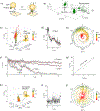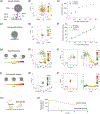Three-Dimensional Tracking of Tethered Particles for Probing Nanometer-Scale Single-Molecule Dynamics Using a Plasmonic Microscope
- PMID: 34786931
- PMCID: PMC8721873
- DOI: 10.1021/acssensors.1c01927
Three-Dimensional Tracking of Tethered Particles for Probing Nanometer-Scale Single-Molecule Dynamics Using a Plasmonic Microscope
Abstract
Three-dimensional (3D) tracking of surface-tethered single particles reveals the dynamics of the molecular tether. However, most 3D tracking techniques lack precision, especially in the axial direction, for measuring the dynamics of biomolecules with a spatial scale of several nanometers. Here, we present a plasmonic imaging technique that can track the motion of ∼100 tethered particles in 3D simultaneously with sub-nanometer axial precision and single-digit nanometer lateral precision at millisecond time resolution. By tracking the 3D coordinates of a tethered particle with high spatial resolution, we are able to determine the dynamics of single short DNA and study its interaction with enzymes. We further show that the particle motion pattern can be used to identify specific and nonspecific interactions in immunoassays. We anticipate that our 3D tracking technique can contribute to the understanding of molecular dynamics and interactions at the single-molecule level.
Keywords: DNA dynamics; SPR imaging; digital ELISA; enzyme dynamics; single-particle 3D tracking.
Figures




Similar articles
-
An Adaptive Real-Time 3D Single Particle Tracking Method for Monitoring Viral First Contacts.Small. 2019 Oct;15(44):e1903039. doi: 10.1002/smll.201903039. Epub 2019 Sep 17. Small. 2019. PMID: 31529595 Free PMC article.
-
Real-time parallel 3D multiple particle tracking with single molecule centrifugal force microscopy.J Microsc. 2019 Mar;273(3):178-188. doi: 10.1111/jmi.12773. Epub 2018 Nov 29. J Microsc. 2019. PMID: 30489640
-
Label-Free Tracking of Single Organelle Transportation in Cells with Nanometer Precision Using a Plasmonic Imaging Technique.Small. 2015 Jun 24;11(24):2878-84. doi: 10.1002/smll.201403016. Epub 2015 Feb 19. Small. 2015. PMID: 25703098 Free PMC article.
-
Three-Dimensional Localization of Single Molecules for Super-Resolution Imaging and Single-Particle Tracking.Chem Rev. 2017 Jun 14;117(11):7244-7275. doi: 10.1021/acs.chemrev.6b00629. Epub 2017 Feb 2. Chem Rev. 2017. PMID: 28151646 Free PMC article. Review.
-
Real-Time 3D Single Particle Tracking: Towards Active Feedback Single Molecule Spectroscopy in Live Cells.Molecules. 2019 Aug 2;24(15):2826. doi: 10.3390/molecules24152826. Molecules. 2019. PMID: 31382495 Free PMC article. Review.
Cited by
-
Label-Free Imaging of Single Proteins and Binding Kinetics Using Total Internal Reflection-Based Evanescent Scattering Microscopy.Anal Chem. 2022 Aug 2;94(30):10781-10787. doi: 10.1021/acs.analchem.2c01510. Epub 2022 Jul 19. Anal Chem. 2022. PMID: 35852494 Free PMC article.
-
Precise Sizing and Collision Detection of Functional Nanoparticles by Deep Learning Empowered Plasmonic Microscopy.Adv Sci (Weinh). 2025 Mar;12(9):e2407432. doi: 10.1002/advs.202407432. Epub 2025 Jan 10. Adv Sci (Weinh). 2025. PMID: 39792780 Free PMC article.
References
-
- Wang Q; Moerner WE, Single-molecule motions enable direct visualization of biomolecular interactions in solution. Nature Methods 2014, 11 (5), 555–558. - PubMed
-
- Wang H; Tang Z; Wang Y; Ma G; Tao N, Probing Single Molecule Binding and Free Energy Profile with Plasmonic Imaging of Nanoparticles. Journal of the American Chemical Society 2019, 141 (40), 16071–16078. - PubMed
-
- Bujak Ł; Piliarik M. In Interferometric scattering (iSCAT) microscopy for high fidelity tracking at microseconds timescales, Nanoimaging and Nanospectroscopy VI, International Society for Optics and Photonics: 2018; p 1072615.
Publication types
MeSH terms
Substances
Grants and funding
LinkOut - more resources
Full Text Sources

